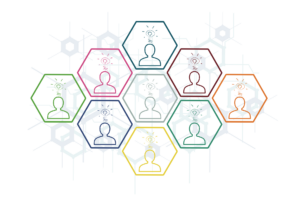Intelligent Agents
Is AI becoming the front end of universal interactivity? And just how will this impact the front end of innovation? It’s a nascent question as we are really on the cusp of knowledge sharing, and interacting, with artificial intelligence. Some important points as a foundation of this strategic philosophy are to realize that we have already established a collective consciousness and that we have perhaps been preparing for computer-enabled human interaction through various cultural moments for decades, such as the evolution of laptops and smartphones. AI is in some ways facilitating a step-change in how computers interact with humans. One can perhaps get ahead of the pace of change, outpacing disruption by consistently repositioning tech and talent.
Still, the future when viewed through AI-human interactivity can seem a bit murky. It is about a scale of mass adoption and invention of a technology that is only at the beginning stages of development and interaction. One expert points to augmented reality and virtual reality as the next wave that will impact consumer devices. Yet, it is with the power of AI that may make this a more possible reality.
As Achin Bhowmik, Chief Technology Officer and Executive Vice President of Engineering at Starkey and adjunct professor at Stanford, writes in a Forbes article, “The Impact Of Human-Technology Interaction: What Comes Next?”: “For these AR and VR devices to go beyond niche applications, they have to enable natural and intuitive human interactions with eye gaze, hand gestures and voice inputs. We’ll interface with technology the same way we interact with other humans. Advances in artificial intelligence (AI), based on machine learning techniques, are increasingly enabling robust computer vision and language understanding technologies that will make this possible.”
Experts are seeing AI as enhancing these immersive experiences through VR and AR headsets. Bhowmik too points at developments in hearing aid technology, which is being updated with AI to create a kind of in-ear personal assistant, enhancing and supporting the hearing aid user experience. And just what else has yet to be explored. What about the interactions between students and AI at a university? How about the interactions between doctors, nurses and patients through more virtual and immersive experiences? What about a consumer dealing with finances with a virtual bank advisor?
All thanks to the development of AI. Bhowmik observes, “Recent breakthrough developments in generative AI based on large language models that are trained with massive amounts of data are already showing us a glimpse of the future of the human-internet interface and interactions. Moving beyond just asking a query and getting an answer in return, we will have deeper conversations with an intelligent agent.”
Enhancing Insights & Innovation
In “Enhancing Insights by Connecting AI, Human Understanding,” All Things Insights recently looked at AI through the context of its H2 2023 edition of the Insights Spend & Trends Report. We discussed the report in the context of AI’s early stages within the insights field, and how the industry seems to be embracing advanced technology with cautious optimism. We then look at the seemingly paradoxical themes of AI and human insights—and how they can work together.
Looking forward to FEI 2024? The conference, which will be held June 10 to 12, will feature a keynote session called “The Front End of Universal Interaction,” presented by Kate Carruthers, Head BI, UNSW AI Institute, Chief Data & Insights Officer at University of New South Wales. Carruthers will share how AI is becoming the Front-End of Universal Interactivity. In looking at the collective consciousness, the evolution of technology, and the development of talent, the presentation will further examine this critical juncture and the burgeoning field of computer-enabled human interaction, fueled by AI. Register for FEI 2024 here.
Infusing Intelligence
Artificial Intelligence is significantly enhancing and impacting the front-end of universal interaction in various ways. We asked ChatGPT, of all places, to detail some of the ways AI is paving the road for more human interaction.
- Personalization: AI-driven personalization algorithms analyze user behavior and preferences, tailoring content and experiences to individual users. This enhances user engagement and satisfaction, providing a more personalized front-end interaction.
- Chatbots and Virtual Assistants: AI-powered chatbots and virtual assistants enhance front-end interactions by providing instant, automated responses to user queries. They improve user experience by offering real-time assistance and support.
- Voice Recognition: AI enables sophisticated voice recognition systems, allowing users to interact with devices and applications using natural language. Voice-controlled front-end interfaces, like virtual assistants, smart speakers, and voice-activated applications, have become increasingly prevalent.
- Image and Video Recognition: AI enables image and video recognition, enhancing interactions through visual data. This technology is used in facial recognition, augmented reality applications, and content recommendation systems, creating a more visually engaging front-end experience.
- Predictive Analytics: AI algorithms analyze large datasets to predict user behavior, enabling businesses to anticipate user needs and preferences. This predictive capability enhances the front-end by presenting users with relevant content or suggestions before they explicitly request them.
- Natural Language Processing (NLP): NLP allows machines to understand, interpret, and generate human-like language. Chatbots, voice interfaces, and language-based searches benefit from NLP, making front-end interactions more intuitive and user-friendly.
- Sentiment Analysis: AI-driven sentiment analysis tools gauge user sentiment from textual data, such as social media posts or customer reviews. This information helps businesses understand user emotions and opinions, allowing them to tailor front-end interactions accordingly.
- Enhanced User Interfaces (UI): AI contributes to the development of adaptive and responsive user interfaces. Front-end interfaces can dynamically adjust based on user preferences, screen size, and device, providing a seamless experience across various platforms.
- Recommendation Systems: AI-powered recommendation systems analyze user behavior and preferences to suggest personalized content or products. This enhances front-end interactions by improving content discovery and increasing user engagement.
- Automation of Routine Tasks: AI automates repetitive tasks, streamlining front-end processes. This includes automating form fillings, data entry, and other mundane tasks, allowing users to focus on more meaningful interactions.
- Gesture Recognition: AI facilitates gesture recognition technologies, enabling users to interact with devices through gestures. This is particularly prevalent in virtual and augmented reality applications, creating immersive front-end experiences.
What’s Next?
AI is transforming the front-end of universal interaction by making it more personalized, intuitive, and adaptive. As these technologies continue to evolve, users can expect even more sophisticated and seamless interactions across various digital platforms.
As Bhowmik puts it in Forbes: “The rapid advances in AI will have a profound impact on how humans and devices interact. It will make our tasks easier while helping us live better and healthier lives. You don’t always know when you’re living in a historical moment, but this is one of those times we’ll look back on and remember how this evolution of technology changed how humans interact with and benefit from the technology around them.”
Video courtesy of Entefy
Contributor
-

Matthew Kramer is the Digital Editor for All Things Insights & All Things Innovation. He has over 20 years of experience working in publishing and media companies, on a variety of business-to-business publications, websites and trade shows.
View all posts



















































































































































